|
|
|
Indian Railways was formed in 1951 when numerous railway systems throughout India were brought together and nationalised. Signalling in India includes two-position semaphore signals, three-position semaphore signals and colour light signals. Two-position semaphores have arms working in the lower quadrant, and three-position semaphores have arms that work in the upper quadrant.
With lower quadrant signalling (excluding "modified lower quadrant signalling"), all main semaphore arms are painted red and show red or green lights at night. A red fishtailed arm (see [2.64 & 2.65]) is referred to as a 'warner' signal in India and is similar in function to a distant signal. Where a warner signal is mounted alone (rather than below a stop arm), a continuously lit green light is placed higher up the post [IN.1 & IN.2] so that it may be distinguished from a stop signal at night. The arrangement of lights is therefore consistent with a warner signal mounted below a cleared stop signal, and avoids trains having to run past a red light under normal circumstances unless there is also a green light visible.
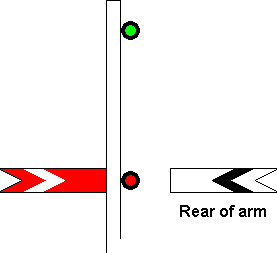 |
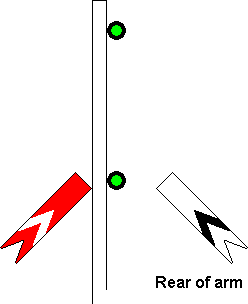 |
| [IN.1] Semaphore Warner Signal on a post by itself ('on'). | [IN.2] Semaphore Warner Signal on a post by itself ('off'). |
|---|
The 1929 General Rules allowed yellow lights to be used in signals for the first time. Yellow semaphore distant arms (see [2.86 & 2.87]) were first used in India in 1933, with a yellow light being shown at night when the arm was in the 'on' ("caution") position. Two-position semaphore signalling employing yellow distant signals is known as "modified lower quadrant signalling". A yellow distant arm is never placed on the same post as a stop signal, a red warner arm being provided in its place where necessary.
Manually operated three-position upper quadrant semaphore signals were introduced to India in 1940. These include three-position stop signals (see [2.83 & 2.84]) as well as three-position distant signals. When indicating "caution", a three-position distant signal appears the same as a two-position lower quadrant distant signal, i.e. a horizontal yellow fishtailed arm, or a yellow light at night (see [2.86]). The arm of a three-position distant signal raised through 45° indicates "attention" [IN.3], advising the driver to be prepared to pass the next signal at restricted speed. The night-time indication for "attention" is two yellow lights displayed vertically one above the other. The arm raised through 90°, or a green light at night, means 'proceed' [IN.4].
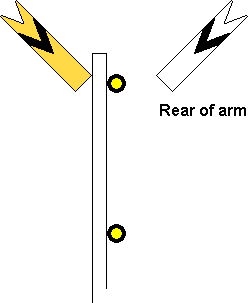 |
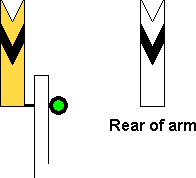 |
| [IN.3] Three-position Distant Signal showing 'Attention'. | [IN.4] Three-position Distant Signal showing 'Proceed'. |
|---|
Semaphore stop signals that apply to goods lines have rings fitted to their arms (see [2.38] and [2.62]). A semaphore stop signal that reads into a dock (bay) platform may have a letter "D" on the arm [IN.5 & IN.6].
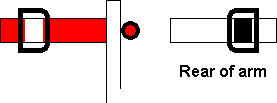 |
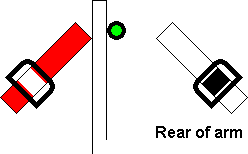 |
| [IN.5] Dock Platform Signal ('on'). | [IN.6] Dock Platform Signal ('off'). |
|---|
Indian colour light signalling is of two, three or four-aspect varieties. In common with British practice, three-aspect signalling uses red, yellow and green aspects, and four-aspect signalling has the double yellow aspect as well. Two-aspect colour light signal aspects, however, are copied from the night-time indications of the Indian two-position lower quadrant semaphore signals in which only red or green lights are used. Where a stop and warner signal are mounted together, the aspects are therefore red over red for "stop", green over red for "caution" or green over green for "proceed". A warner signal mounted alone shows the green over red or green over green aspects.
A semaphore calling-on signal consists of a small white arm with a red stripe on the front [IN.7 - IN.9]. No light is shown while the arm is 'on' [IN.7]. A small yellow light is shown when the arm is 'off' [IN.8]. An upper quadrant arm is used in conjunction with three-position signalling [IN.9]. A calling-on signal associated with a colour light signal comprises a small yellow aspect, which is normally out, positioned below the main signal head.
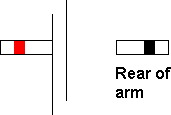 |
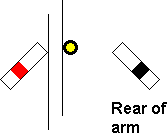 |
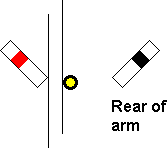 |
| [IN.7] Semaphore Calling-on Signal ('on'). | [IN.8] Lower Quadrant Calling-on Signal ('off'). | [IN.9] Upper Quadrant Calling-on Signal ('off'). |
|---|
Shunting signals in semaphore signalling areas take the form of disc signals (see [4.46]) or miniature semaphore signals. The 'off' indication during darkness is a small green light in two-aspect territory or a small yellow light in multiple aspect territory. Shunting signals in colour light signalling areas comprise position light signals displaying two horizontal white lights for the 'on' aspect (see [4.73]) and two white lights at 45° for the 'off' aspect (see [4.74]).
Whilst position light junction indicators (see [6.51] and [6.54]) in Britain are used exclusively with colour light signals, they have been installed in India also in conjunction with semaphore signals.
Repeater signals in two-aspect signalling territory can either take the form of banners [IN.10 & IN.11] or yellow semaphore arms [IN.12 & IN.13]. In multiple aspect territory, a repeater signal is a colour light signal that shows a yellow aspect when 'on' (see [7.36]) or a green aspect when 'off' (see [7.37]).
 |
 |
| [IN.10] Banner Repeater Signal ('on'). | [IN.11] Banner Repeater Signal ('off'). |
|---|---|
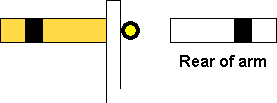 |
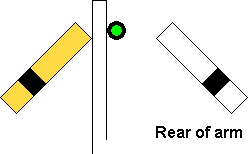 |
| [IN.12] Semaphore Repeater Signal ('on'). | [IN.13] Semaphore Repeater Signal ('off'). |
A warning board, where provided, gives warning of the approach to the first stop signal at a station. The most common type is a black rectangular board bearing a yellow circle between two yellow stripes [IN.14], usually located 1,400 metres before the signal. The post is coloured with alternate black and yellow bands. In two-aspect signalling territory, a separate warning board may be provided for passenger trains in a position closer to the signal, usually at 1,000 metres. This board is marked with black and yellow diagonal stripes [IN.15]. A warning board with black and white diagonal stripes [IN.16] is placed 1,000 feet (305 metres) on the approach to a distant signal in three-position signalling territory.
 |
 |
 |
| [IN.14] Warning Board. | [IN.15] Warning Board for passenger trains. | [IN.16] Warning Board. |
|---|
Certain kinds of signals are identified by having circular marker plates or lights fitted to their posts. A "G" marker plate, with a yellow background, identifies a "gate" stop or distant signal for protecting an interlocked level crossing [IN.17]. The "A" marker plate, introduced in 1936, identifies an automatic stop signal (or a 'delayed stop signal') [IN.18]. In common with former British practice, a semi-automatic stop signal has an "A" marker light, which is illuminated only when the signal is working as an automatic stop signal (see [9.12]). An "A" marker light can also be fitted to a gate stop signal in automatic block signalling territory, in addition to a "G" marker plate (see [IN.17]). The "A" marker will only be lit when the gates are closed across the road. A semi-automatic gate stop signal in automatic block signalling territory (which protects points) carries both an "A" marker light and an "AG" marker light [IN.19]. The "A" marker will only be lit when the gates are closed across the road and the points are correctly set and locked. The "AG" marker is only lit when the gates are not closed across the road but the points are correctly set and locked. If the points are not correctly set and locked, neither marker light will be lit.
 |
 |
 |
| [IN.17] "G" Marker Plate. | [IN.18] "A" Marker Plate. | [IN.19] "AG" Marker Light. |
|---|
An "IB" marker identifies an intermediate block stop signal [IN.20]. A colour light warner or distant signal is fitted with a "P" (for 'permissive') marker [IN.21]. A colour light calling-on signal has an associated "C" marker fixed below it [IN.22].
 |
 |
 |
| [IN.20] "IB" Marker Plate. | [IN.21] "P" Marker Plate. | [IN.22] "C" Marker Plate. |
|---|
A banner or semaphore repeater in a semaphore signalling area (see [IN.10 - IN.13]) is fitted with an "R" marker plate with a white background [IN.23], whereas a repeater in colour light signalling territory has an illuminated "R" marker light [IN.24].
 |
 |
| [IN.23] "R" Marker Plate. | [IN.24] "R" Marker Light. |
|---|
|